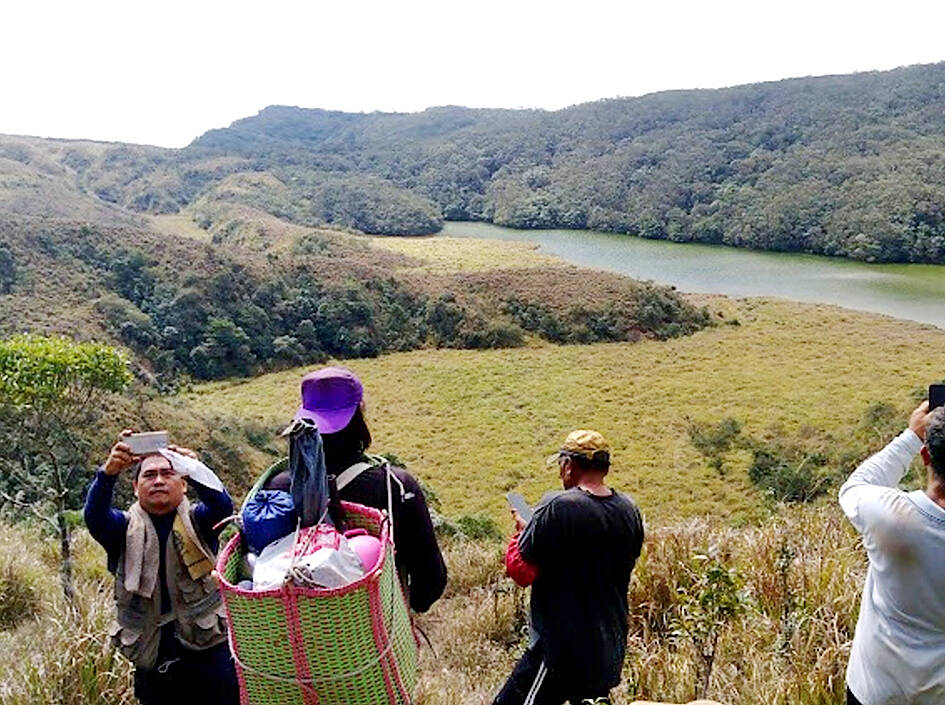The wetlands around Siiaoguei Lake (小鬼湖) in Taitung County is home to one of Taiwan’s most pristine high-elevation habitats and is considered a sacred place by local Rukai communities.
The wetlands are known for their ecological diversity, and while that might be partly due to their remote location in a nearly inaccessible part of Taiwan, they also benefit from a Rukai legend that makes hunting near the lake taboo.
Known in the Rukai language as Taidrengere (“Little Ghost”), the lake sits at an elevation of 2,050m above sea level on the border of Taitung and Pingtung counties. It covers 18 hectares and has a maximum depth of 1.5m.

Photo courtesy of Lravorase Lra-madaralrae via CNA
The area was incorporated into the Dawushan Nature Reserve (大武山自然保留區) when the reserve was established in 1988. It was designated as the Taidrengere Important Wetland in 2018 due to its importance as a wildlife habitat.
The most recent ecological survey of the wetland, conducted from 2020 to 2021 by National Pingtung University of Science and Technology professor Wang Chih-chiang (王志強), recorded 23 mammal species, including the endangered Formosan black bear and Formosan serow.
The survey also documented 41 species of birds, two reptile species, five amphibian species and two types of fish, as well as 158 plant species, of which 10 were on the International Union for Conservation of Nature and Natural Resources’ Red List of threatened species.
As with many high-elevation lakes, Siiaoguei Lake was originally fishless, although it now has established populations of common carp and pond loaches, Taitung Forest District Office head Wu Chang-yu (吳昌祐) said.
The common carp is the lone survivor of a 1979 Pingtung County Government initiative that also tried to introduce catfish and grass carp to the lake, while the pond loaches — which normally live at low elevations — were likely released by a visitor, Wu said.
The Rukai legend that has helped keep the area’s environment pristine is the story of “Princess Baleng and the Snake King.”
Versions of the legend abound, many of which were collected and preserved by late folklorist and Taromak village warden Su Chin-cheng (蘇金成).
In the most widely circulated version of the story, the daughter of a Rukai chieftain named Princess Baleng meets a young man named Adalio at the lake and falls in love with him.
However, on the day of their wedding, Adalio arrives in the form of a hundred-pace snake at the head of a party of wild animals.
Baleng’s family, recognizing Adalio as an incarnation of the “Snake King” that protects the area, opposes going through with the marriage, but is also wary of offending the suitor.
Hoping to dissuade him, they demand that Adalio pay the bride price in seven-colored glass beads, which could only be obtained by descending the mountain and collecting them from the sea.
Surprising the princess’ family, the Snake King retrieves the beads and is allowed to marry Baleng. Immediately afterward, the two disappear into the lake and are never seen or heard from again.
Because of this legend, Rukai view the lake as a sacred site and enforced taboos against hunting or making excessive noise there.
Su said a belief later developed among Rukai that the lake became the eternal resting place of the couple’s souls after their death.
Su said that, before her passing, his mother comforted her loved ones by saying that her soul “would go visit family and friends, and then return to the lake to reunite with her ancestors.”
Other versions of the story vary widely. In one telling, the lake is a child born to Princess Baleng and the Snake King, while in another, the princess and a young man from another tribe commit suicide in the lake after their families reject their union.
Regardless of the version, the legend, and its important place in Rukai culture, have contributed to the conservation of the area’s ecosystem.
In recent years, young Rukai have organized regular expeditions to the lake with their elders to better understand their history.
The Taitung-based branch of Rukai — Taromak, or eastern Rukai — completed a survey of its traditional lands in 2018.

Chinese Nationalist Party (KMT) Chairman Eric Chu (朱立倫), spokeswoman Yang Chih-yu (楊智伃) and Legislator Hsieh Lung-chieh (謝龍介) would be summoned by police for questioning for leading an illegal assembly on Thursday evening last week, Minister of the Interior Liu Shyh-fang (劉世芳) said today. The three KMT officials led an assembly outside the Taipei City Prosecutors’ Office, a restricted area where public assembly is not allowed, protesting the questioning of several KMT staff and searches of KMT headquarters and offices in a recall petition forgery case. Chu, Yang and Hsieh are all suspected of contravening the Assembly and Parade Act (集會遊行法) by holding

PRAISE: Japanese visitor Takashi Kubota said the Taiwanese temple architecture images showcased in the AI Art Gallery were the most impressive displays he saw Taiwan does not have an official pavilion at the World Expo in Osaka, Japan, because of its diplomatic predicament, but the government-backed Tech World pavilion is drawing interest with its unique recreations of works by Taiwanese artists. The pavilion features an artificial intelligence (AI)-based art gallery showcasing works of famous Taiwanese artists from the Japanese colonial period using innovative technologies. Among its main simulated displays are Eastern gouache paintings by Chen Chin (陳進), Lin Yu-shan (林玉山) and Kuo Hsueh-hu (郭雪湖), who were the three young Taiwanese painters selected for the East Asian Painting exhibition in 1927. Gouache is a water-based

Taiwan would welcome the return of Honduras as a diplomatic ally if its next president decides to make such a move, Minister of Foreign Affairs Lin Chia-lung (林佳龍) said yesterday. “Of course, we would welcome Honduras if they want to restore diplomatic ties with Taiwan after their elections,” Lin said at a meeting of the legislature’s Foreign Affairs and National Defense Committee, when asked to comment on statements made by two of the three Honduran presidential candidates during the presidential campaign in the Central American country. Taiwan is paying close attention to the region as a whole in the wake of a

OFF-TARGET: More than 30,000 participants were expected to take part in the Games next month, but only 6,550 foreign and 19,400 Taiwanese athletes have registered Taipei city councilors yesterday blasted the organizers of next month’s World Masters Games over sudden timetable and venue changes, which they said have caused thousands of participants to back out of the international sporting event, among other organizational issues. They also cited visa delays and political interference by China as reasons many foreign athletes are requesting refunds for the event, to be held from May 17 to 30. Jointly organized by the Taipei and New Taipei City governments, the games have been rocked by numerous controversies since preparations began in 2020. Taipei City Councilor Lin Yen-feng (林延鳳) said yesterday that new measures by